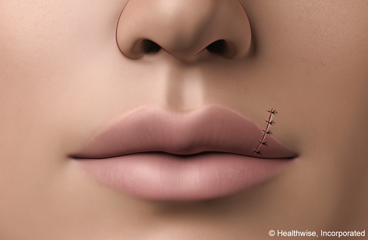
Overview
A cut (laceration) on your lip can be on the outside of your mouth, or it may include the skin inside your mouth. Cuts to the lip usually heal quickly. But your lip may be sore while it heals.
The doctor used stitches to close the cut. Using stitches helps the cut heal. The doctor may also have called in a specialist, such as a plastic surgeon, to close the cut.
Your cut may leave a scar that will fade over time. The doctor took special care to close the cut so that the edges line up. This can help reduce scarring.
If the cut went deep and through the skin, the doctor may have put in two layers of stitches. The deeper layer brings the deep part of the cut together. These stitches will dissolve and don't need to be removed. The stitches in the upper layer are the ones you see on the cut. You may have strips of tape covering part of the cut.
Your stitches may dissolve on their own. Or the doctor may need to remove the stitches in about 3 to 5 days.
The doctor has checked you carefully, but problems can develop later. If you notice any problems or new symptoms, get medical treatment right away.
Follow-up care is a key part of your treatment and safety. Be sure to make and go to all appointments, and call your doctor if you are having problems. It's also a good idea to know your test results and keep a list of the medicines you take.
How can you care for yourself at home?
- Put ice or a cold pack on the area for 10 to 20 minutes at a time. Put a thin cloth between the ice and your skin.
- If the cut is inside your mouth:
- Rinse your mouth with warm salt water right after meals. Saltwater rinses may help healing. To make a saltwater solution for rinsing the mouth, mix 1 tsp of salt in 1 cup of warm water.
- Eat soft foods that are easy to chew. Avoid foods that might sting. These include salty or spicy foods, citrus fruits or juices, and tomatoes.
- Try using a topical medicine, such as Orabase, to reduce mouth pain.
- Do not use a straw until your lip is healed.
- If your doctor told you how to care for your cut, follow your doctor's instructions. If you did not get instructions, follow this general advice:
- After the first 24 to 48 hours, wash around the cut with clean water 2 times a day. Don't use hydrogen peroxide or alcohol, which can slow healing.
- If you have strips of tape on the cut, leave the tape on for a week or until it falls off.
- If your doctor prescribed antibiotics, take them as directed. Do not stop taking them just because you feel better. You need to take the full course of antibiotics.
- Be safe with medicines. Read and follow all instructions on the label.
- If the doctor gave you a prescription medicine for pain, take it as prescribed.
- If you are not taking a prescription pain medicine, ask your doctor if you can take an over-the-counter medicine.
- Avoid any activity that could cause the cut to reopen.
- Do not remove the stitches on your own. Your doctor will tell you when to come back to have the stitches removed.
When should you call for help?
Call your doctor now or seek immediate medical care if:
- The cut starts to bleed. Oozing small amounts of blood is normal.
- You have symptoms of infection, such as:
- Increased pain, swelling, warmth, or redness around the cut.
- Red streaks leading from the cut.
- Pus draining from the cut.
- A fever.
Watch closely for changes in your health, and be sure to contact your doctor if:
- The cut reopens.
- You do not get better as expected.
Where can you learn more?
Go to http://www.healthwise.net/patientEd
Enter H870 in the search box to learn more about "Lip Laceration: Care Instructions".
Current as of: October 1, 2025
Author: Ignite Healthwise, LLC Staff
Clinical Review Board
All Ignite Healthwise, LLC education is reviewed by a team that includes physicians, nurses, advanced practitioners, registered dieticians, and other healthcare professionals.

